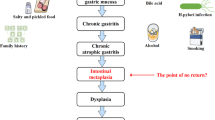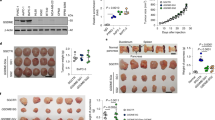Abstract
Our previous studies, in specimens of large intestine resected for carcinoma, have shown abnormal patterns of mucous secretion in areas of apparently "normal" mucosa, where goblet cells produce mainly sialomucins as compared with the true normal colonic mucosa in which sulphomucins predominate. In the present work, large bowel cancer was induced in rats by the administration of 1,2-dimethylhydrazine-2HCl (DMH). We attempted to study the sequential histological and secretory abnormalities which developed in the colonic epithelium during carcinogenesis, and to correlate these changes with those described above in the human. The microscopical and histological lesions observed in the colonic mucosa of DMH treated rats confirmed the findings of other authors and resembled the human colorectal cancer. The earliest changes detected were small foci of hyperplasia accompanied from the 6th week onwards by several foci of dysplasia. Carcinoma in situ appeared at the 15th week and finally invasive carcinoma developed from the 19th week onwards. Changes in the type of mucous secretion, with predominance of sialomucins, were observed in the majority of the areas showing mild to moderate dysplasia whilst the surrounding normal epithelium produced suphated material. Mucous depletion was a common feature in areas of severe dysplasia and carcinoma. These findings correlated well with the similar variations in the mucin composition observed in human colonic mucosa in carcinoma and further supported our previous hypothesis that mucin changes characterized by an increase in sialomucins might reflect early malignant transformation. If this hypothesis proved to be correct, the use of a simple method for the identification of mucins in large bowel biopsies would be of great help in detecting early malignancy.
This is a preview of subscription content, access via your institution
Access options
Subscribe to this journal
Receive 24 print issues and online access
$259.00 per year
only $10.79 per issue
Buy this article
- Purchase on Springer Link
- Instant access to full article PDF
Prices may be subject to local taxes which are calculated during checkout
Similar content being viewed by others
Rights and permissions
About this article
Cite this article
Filipe, M. Mucous secretion in rat colonic mucosa during carcinogenesis induced by dimethylhydrazine. A morphological and histochemical study. Br J Cancer 32, 60–77 (1975). https://doi.org/10.1038/bjc.1975.134
Issue Date:
DOI: https://doi.org/10.1038/bjc.1975.134
This article is cited by
-
Experimental models of colorectal cancer
Diseases of the Colon & Rectum (1998)
-
Effect ofN-methy-N′-nitro-N-nitrosoguanidine on carbohydrate profiles of non-metaplastic rat gastric mucosa
Journal of Cancer Research and Clinical Oncology (1993)
-
Histochemical study of colonic cancer in experimental colitis of rats
Digestive Diseases and Sciences (1993)
-
Normal colon of Sprague-Dawley rats
Anatomy and Embryology (1992)
-
Biopathologic characteristics of DNA content in crypt cells of transitional mucosa adjacent to carcinomas of the rectum and rectosigmoid
Diseases of the Colon & Rectum (1992)



